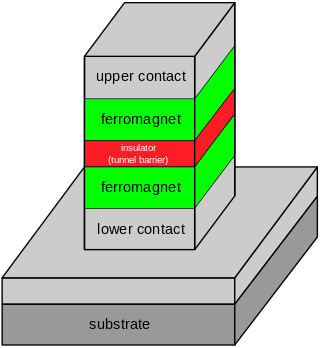Non-volatile random-access memory (NVRAM) is random-access memory that retains data without applied power. This is in contrast to dynamic random-access memory (DRAM) and static random-access memory (SRAM), which both maintain data only for as long as power is applied, or forms of sequential-access memory such as magnetic tape, which cannot be randomly accessed but which retains data indefinitely without electric power.
Magnetoresistive random-access memory (MRAM) is a type of non-volatile random-access memory which stores data in magnetic domains. Developed in the mid-1980s, proponents have argued that magnetoresistive RAM will eventually surpass competing technologies to become a dominant or even universal memory. Currently, memory technologies in use such as flash RAM and DRAM have practical advantages that have so far kept MRAM in a niche role in the market.
Non-volatile memory (NVM) or non-volatile storage is a type of computer memory that can retain stored information even after power is removed. In contrast, volatile memory needs constant power in order to retain data.

Tunnel magnetoresistance (TMR) is a magnetoresistive effect that occurs in a magnetic tunnel junction (MTJ), which is a component consisting of two ferromagnets separated by a thin insulator. If the insulating layer is thin enough, electrons can tunnel from one ferromagnet into the other. Since this process is forbidden in classical physics, the tunnel magnetoresistance is a strictly quantum mechanical phenomenon, and lies in the study of spintronics.
Nano-RAM is a proprietary computer memory technology from the company Nantero. It is a type of nonvolatile random-access memory based on the position of carbon nanotubes deposited on a chip-like substrate. In theory, the small size of the nanotubes allows for very high density memories. Nantero also refers to it as NRAM.

Magnetic storage or magnetic recording is the storage of data on a magnetized medium. Magnetic storage uses different patterns of magnetisation in a magnetizable material to store data and is a form of non-volatile memory. The information is accessed using one or more read/write heads.

Giant magnetoresistance (GMR) is a quantum mechanical magnetoresistance effect observed in multilayers composed of alternating ferromagnetic and non-magnetic conductive layers. The 2007 Nobel Prize in Physics was awarded to Albert Fert and Peter Grünberg for the discovery of GMR, which also sets the foundation for the study of spintronics.

Ferroelectric RAM is a random-access memory similar in construction to DRAM but using a ferroelectric layer instead of a dielectric layer to achieve non-volatility. FeRAM is one of a growing number of alternative non-volatile random-access memory technologies that offer the same functionality as flash memory. An FeRAM chip contains a thin film of ferroelectric material, often lead zirconate titanate, commonly referred to as PZT. The atoms in the PZT layer change polarity in an electric field, thereby producing a power-efficient binary switch. However, the most important aspect of the PZT is that it is not affected by power disruption or magnetic interference, making FeRAM a reliable nonvolatile memory.

Stuart Stephen Papworth Parkin is an experimental physicist, director at the Max Planck Institute of Microstructure Physics in Halle and an Alexander von Humboldt Professor at the Institute of Physics of the Martin-Luther-University Halle-Wittenberg.

Spin-transfer torque (STT) is an effect in which the orientation of a magnetic layer in a magnetic tunnel junction or spin valve can be modified using a spin-polarized current.
Micron Memory Japan, K.K.(Japanese: マイクロンメモリジャパン株式会社, Micron Memory Japan Kabushiki-gaisha ) is a Japanese subsidiary of Micron Technology. It was formerly known as Elpida Memory, Inc. established in 1999 that developed, designed, manufactured and sold dynamic random-access memory (DRAM) products. It was also a semiconductor foundry. With headquarters in Yaesu, Chūō, Tokyo, Japan, it was initially formed under the name NEC Hitachi Memory in 1999 by the merger of the Hitachi and NEC DRAM businesses. In the following year it took on the name Elpida. In 2003, Elpida took over the Mitsubishi DRAM business. In 2004, it listed its shares in the first section of the Tokyo Stock Exchange. In 2012, those shares were delisted as a result of its bankruptcy. In 2013, Elpida was acquired by Micron Technology. On February 28, 2014, Elpida changed its name to Micron Memory Japan and Elpida Akita changed its name to Micron Akita, Inc.
nvSRAM is a type of non-volatile random-access memory (NVRAM). nvSRAM extends the functionality of basic SRAM by adding non-volatile storage such as an EEPROM to the SRAM chip. In operation, data is written to and read from the SRAM portion with high-speed access; the data in SRAM can then be stored into or retrieved from the non-volatile storage at lower speeds when needed.
Racetrack memory or domain-wall memory (DWM) is an experimental non-volatile memory device under development at IBM's Almaden Research Center by a team led by physicist Stuart Parkin. In early 2008, a 3-bit version was successfully demonstrated. If it were to be developed successfully, racetrack memory would offer storage density higher than comparable solid-state memory devices like flash memory.
Double Data Rate 4 Synchronous Dynamic Random-Access Memory is a type of synchronous dynamic random-access memory with a high bandwidth interface.

Netlist Inc. is a Delaware-registered corporation headquartered in Irvine, California that designs and sells high-performance SSDs and modular memory subsystems to enterprise customers in diverse industries. It also manufactures a line of specialty and legacy memory products to storage customers, appliance customers, system builders and cloud and datacenter customers. Netlist holds a portfolio of patents in the areas of server memory, hybrid memory, storage class memory, rank multiplication and load reduction. Netlist has more than 120 employees and an annual revenue of US$142.4 million as of 2021 The stock was added to NASDAQ in late 2006. In the initial public offering of its common stock in 2006, Netlist sold 6,250,000 shares at $7.00 each. On September 26, 2018, Netlist announced they were moving from NASDAQ and currently trades on the OTCQB.
A NVDIMM or non-volatile DIMM is a type of persistent random-access memory for computers using widely used DIMM form-factors. Non-volatile memory is memory that retains its contents even when electrical power is removed, for example from an unexpected power loss, system crash, or normal shutdown. Properly used, NVDIMMs can improve application performance and system crash recovery time. They enhance solid-state drive (SSD) endurance and reliability.
Grandis, Inc. was founded in 2002 by Dr. Paul Nguyen and Bill Almon. Farhad Tabrizi later joined as CEO. It was backed by venture capital firms such as Sevin Rosen Funds and Matrix Partners to pioneer non-volatile solutions based on spintronics. The solutions it developed was thin-film memory, which included the invention of spin transfer torque - random access memory (STT-RAM).
Virtium Solid State Storage and Memory is a privately held American company that manufactures semiconductor memory and solid-state disk (SSD) products for data storage in industrial/machine-to-machine designs, embedded systems, including small-footprint designs, and Industrial Internet of Things (IIoT) applications. The company's primary markets of focus include defense, industrial systems, network communications, and transportation. The name Virtium is derived from the word virtue.
Bernard Dieny is a research scientist and an entrepreneur. He is Chief Scientist at SPINTEC, a CEA/CNRS/UGA research laboratory that he co-founded in 2002 in Grenoble, France. He is also co-founder of two startup companies: Crocus Technology on MRAM and magnetic sensors in 2006 and EVADERIS on circuits design in 2014.
Guohan Hu is an electrical engineer specializing in magnetic storage and spintronics, and especially in the use of spin-transfer torque in magnetoresistive RAM, a type of non-volatile random-access memory. She works for IBM Research at the Thomas J. Watson Research Center as a distinguished research staff member and manager of the MRAM Materials and Devices group.







